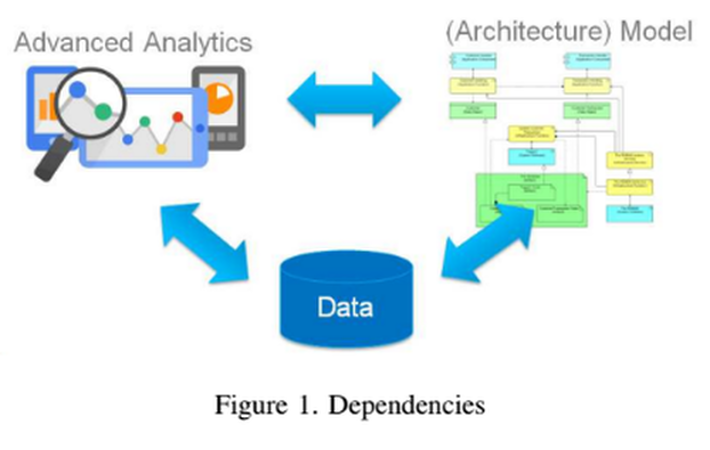
Published on 02/08/2017 | Technology
Enterprise architecture (EA) research has reached a certain level of maturity, thus the question right now is: What are the next EA challenges? In this paper, thoughts motivated and derived from use cases of applying EA in manufacturing industry are shared to achieve better, faster and low cost end to end digital and Industry 4.0 transformation. New EA capabilities are required and we call it Digitial Enterprise Architecture. The proposal is to work on tools and methods to interactively work with models to solve a business problem based on as many factual insights as possible.
Classical Enterprise Architecture (EA) methods and approaches are IT (Information Technology) driven resulting in potentially multiple models maintained by a small group of IT experts. The focus of the models are IT infrastructure, applications, information flow and sometimes processes, which are on a rather high abstraction level. Recently, architecture modeling languages are including the physical domain, like e.g. Archimate version 3. Including the physical layer allows to extend the models from pure IT scenarios to Operation Technology (OT) scenarios in manufacturing industry. Combining IT and OT is driven by initiatives known as Industry 4.0, smart manufacturing, or Industrial Internet of Things (IIoT) worldwide. The basic concept of these initiatives is to increase the information flow and the integration of systems reaching from machines in the shop-floor to business applications (like e.g. finance) in the same organization as well as integrating systems along the supply chain: this is also known as horizontal and vertical integration. We have observed at several projects in the field that many of these integration projects fail or at least are out of budget and over time. The reasons are related to digitization and the increasing complexity of the involved shop-floor systems, processes and applications.
Another trend in manufacturing is to extend the existing continuous improvement cycles by using advanced data analytics. The motivation is that established approaches, like e.g. Lean Six Sigma, have been applied successfully, however, the possible improvements are getting smaller and smaller over time, while the market demands agility, speed and user experience. Thus, new approaches and techniques are required to get new insights on data and to increase the benefits of a single improvement step again. The manufacturers are often forced to speed up product life cycles and therefore need to be more efficient. However, the interpretation of analysis results in manufacturing requires a good understanding of the origin of the data, the production line, as well as the related processes generating the data.
Our vision for Digital Enterprise Architecture is that (architecture) models, data and analytics depend on each other and that methods and tools are needed to have these three dimensions available in a shared environment to benefit from each other (see image below). In particular, a model is required to understand the data and the analysis results. Further, the data is needed to quantify design options in the model and as a basis for advanced analytics. Finally, advanced analytics results can give an indication on the compliance of the model with the real world and the data quality.
This vision for Digital Enterprise Architecture requires to change the way of working with models and enhance the information you can extract from the integrated concepts. Besides this technical aspect, a change in methodology and mentality of working with the integrated concepts is required, to enable the agility, speed and user experience expected by the users. In this paper the requirements for Digital Enterprise Architecture are derived from several use cases conducted with multiple projects and industries. These initial requirements are first discussed in more general terms and are subsequently explained in more detail.

The derived requirements are based on the following use cases in the process and discrete industry.
2.1. Process Industry
The process industry is manufacturing products in batches which potentially will be transformed into discrete objects.
• production of polishing material for silicon wafers: decision support for a data ingestion and analytics infrastructure based on a model to compare different design alternatives using several KPI’s under consideration of the strategic goals of the organization.
• extrusion process producing raw material for automotive industry: documentation of analysis infrastructure and relation of analysis results with the shop-floor setup
• steel production processes: support for defining a process improvement project on the shopfloor for batch annealing to increase the throughput of the line by integrating a part of the shopfloor equipment in the manufacturing execution system
2.2. Discrete Industry
In the discrete industry products are assembled from multiple parts.
• High frequency assembly for white goods: migrate and integrate to a standard Manufacturing Execution System (MES), facing go live and business acceptance challenges. The approach was to analyze the material provisioning to the line by modelling the processes in the MES and checking conformance of the model based on process models derived from data collected during the execution of the systems.
• Low frequency assembly for health care products: support for application harmonization in different plants, in particular, supporting the deployment of templates for Manufacturing Execution Systems per plant.
2.3. Underlying Business Topics
Although the focus in the different case studies has been quite different, while executing the projects a list of topics relevant to the business have been identified. These topics are rather general and its instantiation for a particular customer may vary. However, each topic has been mentioned by several customers and therefore the topics seem to be a reasonable list as a basis of our investigation.
• Find possible solutions to improve KPI’s of the business (like e.g. yield) beyond Six Sigma and Lean: advanced analytics requires collection of data, understanding the underlying processes and infrastructure, and applying advanced analytics techniques to identify optimized machine configurations, automation potentials or training of personal.
• Transfer best practices from one plant/line to the next one: analysis can derive the commonalities and differences between the different lines, since almost all plants producing the same product have a slightly different setup of machines and IT/OT infrastructure as well as processes and capabilities.
• Decide on solution alternatives using facts rather than guts: analysis of the performance and requirements of the current and future systems can be used to provide a factual and measurable line of reasoning (e.g. a business case) of a solution alternative supporting decision making.
All the above topics are related to some data or facts, require an understanding of the related process and infrastructure, and are based on some sort of analytics. The motivation for these topics is to improve the business KPI’s by facilitating all available information. These topics are often addressed under the terms Industry 4.0, Smart Advanced Manufacturing or Industrial Internet of Things (IIoT), which addresses the digitization and integration of vertical and horizontal value chains.
Further, all these questions can be categorized as business transformations. These transformations become more complex the more the digitization and integration has progressed in an organization, because the number of systems and connections between systems increases almost exponentially. This increasing complexity causes many of the current transformation projects to be out of budget and over time. Business transformations in the IT world are often supported by Enterprise Architecture models and tools, but no data. Decision support for design alternatives can be addressed with Portfolio Management applications, which are based on applications and data, but usually no processes. In the manufacturing world, integration projects use standards like ISA-95 for describing the interaction between level 3 (MES, thus OT) and level 4 (ERP, IT), but no data.
Thus, existing approaches are not able to address the above business topics. We propose that Digital EA supports these questions, however, this poses new requirements on EA tooling and related approaches.
2.4. Requirements for Digital EA
The following requirements are derived from our experiences in our use cases on addressing the business topics with EA and related models using existing tooling. While building the models to address the business topics as discussed above, we made the following observations:
1) Many concepts in the model are managed and maintained in other applications (like e.g. customer database (CRM), products (PLM), control of the production process (MES)): importing and versioning of model parts from external applications is a necessity and tool support is required.
2) The model is related to quite some data (like e.g. all model layers have a notion of cost, business transformation is related to a KPI improvement, processes are related to usage frequency, infrastructure and physical layer have related numerical configuration parameters as well as performance metrics like mean time to failure or utilization): data import and data management capabilities in the model and according tool support is required.
3) The model contains e.g. the same process in different abstractions and level of details as well as from different point of view: like e.g. UI perspective, system perspective, or product perspective: different perspectives must be consistent, should be derivable and distinguishable from each other.
4) Due to the complexity of the model, a different way of editing and validating a model is required.
(like e.g. it is not feasible anymore to manually search for a concept, but concepts and relations are queried): new model editing capabilities to deal with the increased amount of concepts in the model are required.
5) Answering the business topics requires rich analytics and query capabilities (like e.g. graph traversals, subgraph pattern matching, and basic analytics combining data and graphs): rich and fast analytics capabilities are required.
6) Analysis requires that certain constructs in processes, applications or infrastructure are always modelled in the same way, otherwise it is very difficult to perform analysis on the models: analytics on the model requires model patterns and their consistent usage.
The above requirements are related with each other in Fig 2. In the following sections some key points of customer discussions are shared, describing in more detail some aspects of the requirements and motivating some of them by use cases in manufacturing.
Read Part 2 of the article here.